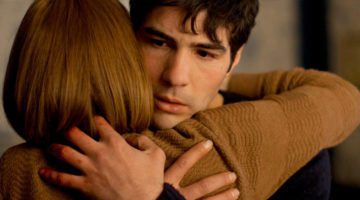Review: The Scarehouse
The Scarehouse is an ambitious and daring project from Windsor, Ontario husband and wife team Gavin Michael Booth and Sarah Booth, (both listed as writers, him as director and her as lead actress). What surprises about the film, though, is despite its horror-minded leaning, and adherence to tropes and styles, this film subverts the horror genre by seemingly being minded on something quite different than scares: an examination of body politics, especially female.
The film opens with a seemingly out-of-place scene of sorority girls on their way to a party, laughing and joking and appearing to have a great time. While funny, the scene seemed to belong to a different film, especially when the coming scenes feature a couple of the characters, Corey Peters and Elaina Forster, (Booth and Kimberly-Sue Murray) in a completely detached context, inviting members of the sorority into the titular Scarehouse on Devil’s Night for a gruesome section of torture porn, of which most audiences have not seen the likes since perhaps Eli Roth’s oeuvre.
But here’s the thing about The Scarehouse: the house, and the movie as a whole is not very scary, at least not in the conventional sense. What is scary about The Scarehouse is its obsession with the body, particularly the rudeness and wetness of body politics. To a sense, the filmmakers seem aware of it, and a montage of one characters filthy mouth and obsession with a certain C-Word seem to bear out this theory. But it is more than just that sequence, as the first two ghastly scenes involve scenes of binding and fat shaming, and extreme close-ups of vomit and urine, and a sequence that focuses upon breasts implants, and focusses upon how a character uses her body as a sort of tool, and the removal of the implements of power. Also, a later scene focusses upon Corey’s need to find a bathroom, and, interestingly, the scene is not played for laughs in a way that a gross-out film might, nor is it a major turning point of the story, but it is just left there, matter of fact, in an earthy way that does not seem to exist for a reason other than to draw attention back to the body. Then there are the scenes of sex acts, and the part of the story where Peters and Forrester are almost forgiven for their actions, (the film jumps back and forth in time to explain the backstory).
But in the end, it felt almost like the Booths were too concerned with the high-mindedness of the female protagonists, and it would have been more interesting to see them stay in the mud.
[star v=35]







